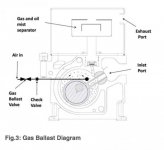Hey everyone. So for a bunch of reasons, I had to stop growing and making concentrates for the past 3 years. Getting married and having a kid took a lot more time out of my schedule than I expected lol.
I have an MKIII I purchased from terpp about 3 years ago. I ran it less than ten times, and since then all my equipment has been sitting in the garage for the entire time. I finally have time to start running it again, so I got everything cleaned up today and put back together. I changed the oil in my robinair (the same oil had been sitting in the pump for the entire hiatus), hooked it up to the MKIII, threw it on and started pulling a vacuum. It got down to 28.5hg easily. And then it just stalled. I noticed the pump was smoking basically until I shut the valve off on my pump.
Right now the vacuum has been holding for a few hours, going to see if it holds through the night. Anyone know what might be up? Is the pump shot? I would think not only because it has less than probably 10 hours of total use on it. I am thinking maybe there might be a leak on the actual MKIII.
Appreciate any feedback & thanks in advance.
aod
I have an MKIII I purchased from terpp about 3 years ago. I ran it less than ten times, and since then all my equipment has been sitting in the garage for the entire time. I finally have time to start running it again, so I got everything cleaned up today and put back together. I changed the oil in my robinair (the same oil had been sitting in the pump for the entire hiatus), hooked it up to the MKIII, threw it on and started pulling a vacuum. It got down to 28.5hg easily. And then it just stalled. I noticed the pump was smoking basically until I shut the valve off on my pump.
Right now the vacuum has been holding for a few hours, going to see if it holds through the night. Anyone know what might be up? Is the pump shot? I would think not only because it has less than probably 10 hours of total use on it. I am thinking maybe there might be a leak on the actual MKIII.
Appreciate any feedback & thanks in advance.
aod



